AP2/EREBP Pathway Plays an Important Role in Chaling Wild Rice Tolerance to Cold Stress
Abstract
:1. Introduction
2. Results
2.1. Identification of Genes for AP2 Family Proteins in Rice
2.2. AP2 Family Analysis among Different Species Screening of AP2 Gene Family in Rice, Maize, and Arabidopsis thaliana
2.3. A Collinearity Analysis of AP2 in Rice
2.4. AP2 Gene Family Analysis
2.5. Comparison of Cold-Regulated AP2/EREBP Family Genes in Chaling Wild Rice and Pei’ai 64S
2.6. Sequence Analysis of Promoters of AP2/EREBP Genes
2.7. Conservation of Upstream and Downstream AP2/EREBP Gene Family
2.8. Comparison of Upstream and Downstream Genes of Six Rice Species
2.9. Differential Regulation of AP2 Pathway Genes in Recombinant Inbred Lines from Nipponbare Crossing with Chaling Wild Rice (NC)
3. Discussion
4. Materials and Methods
4.1. Plant Materials and Conditions
4.2. Extraction of Total RNA and Quantitative PCR
4.3. Microarray Data Analysis
4.4. Analysis of AP2 Protein in Rice
4.5. Promoter Analysis
4.6. AP2 Family Analysis among Different Species
4.7. Analysis of Upstream Gene of AP2 Family
5. Conclusions
Supplementary Materials
Author Contributions
Funding
Institutional Review Board Statement
Informed Consent Statement
Data Availability Statement
Conflicts of Interest
References
- Chen, R.; Deng, Y.; Ding, Y.; Guo, J.; Qiu, J.; Wang, B.; Wang, C.; Xie, Y.; Zhang, Z.; Chen, J.; et al. Rice Functional Genomics: Decades’ Efforts and Roads Ahead. Sci. China Life Sci. 2022, 65, 33–92. [Google Scholar] [CrossRef] [PubMed]
- Londo, J.P.; Chiang, Y.-C.; Hung, K.-H.; Chiang, T.-Y.; Schaal, B.A. Phylogeography of Asian Wild Rice, Oryza Rufipogon, Reveals Multiple Independent Domestications of Cultivated Rice, Oryza Sativa. Proc. Natl. Acad. Sci. USA 2006, 103, 9578–9583. [Google Scholar] [CrossRef] [PubMed]
- Huang, X.; Kurata, N.; Wei, X.; Wang, Z.-X.; Wang, A.; Zhao, Q.; Zhao, Y.; Liu, K.; Lu, H.; Li, W.; et al. A Map of Rice Genome Variation Reveals the Origin of Cultivated Rice. Nature 2012, 490, 497–501. [Google Scholar] [CrossRef] [PubMed]
- Almeida, D.M.; Almadanim, M.C.; Lourenço, T.; Abreu, I.A.; Saibo, N.J.M.; Oliveira, M.M. Screening for Abiotic Stress Tolerance in Rice: Salt, Cold, and Drought. Methods Mol. Biol. 2016, 1398, 155–182. [Google Scholar] [CrossRef]
- Lenka, S.K.; Muthusamy, S.K.; Chinnusamy, V.; Bansal, K.C. Ectopic Expression of Rice PYL3 Enhances Cold and Drought Tolerance in Arabidopsis thaliana. Mol. Biotechnol. 2018, 60, 350–361. [Google Scholar] [CrossRef]
- Mukhopadhyay, A.; Vij, S.; Tyagi, A.K. Overexpression of a Zinc Finger Protein Gene from Rice Confers Tolerance to Cold, Dehydration, and Salt Stress in Transgenic Tobacco. Proc. Natl. Acad. Sci. USA 2004, 101, 6309–6314. [Google Scholar] [CrossRef]
- da Cruz, R.P.; Sperotto, R.A.; Cargnelutti, D.; Adamski, J.M.; de FreitasTerra, T.; Fett, J.P. Avoiding Damage and Achieving Cold Tolerance in Rice Plants. Food Energy Secur. 2013, 2, 96–119. [Google Scholar] [CrossRef]
- Ashraf, M.A.; Rahman, A. Cold Stress Response in Arabidopsis thaliana Is Mediated by GNOM ARF-GEF. Plant J. 2019, 97, 500–516. [Google Scholar] [CrossRef]
- Liu, C.; Schläppi, M.R.; Mao, B.; Wang, W.; Wang, A.; Chu, C. The BZIP73 Transcription Factor Controls Rice Cold Tolerance at the Reproductive Stage. Plant Biotechnol. J. 2019, 17, 1834–1849. [Google Scholar] [CrossRef]
- Hannah, M.A.; Wiese, D.; Freund, S.; Fiehn, O.; Heyer, A.G.; Hincha, D.K. Natural Genetic Variation of Freezing Tolerance in Arabidopsis. Plant Physiol. 2006, 142, 98–112. [Google Scholar] [CrossRef]
- Dai, L.Y.; Kariya, K.; Ye, C.; Ise, K.; Tanno, H.; Yu, T.Q.; Xu, F.R.; Ma, C.W. Studies on Cold Tolerance of Rice, Oryza sativa, L., II. Evaluation on Cold Tolerance of Yunnan Rice Genetic Resources. Southwest China J. Agric. Sci. 2002, 15, 47–52. [Google Scholar]
- Satake, T.; Hayase, H. Male Sterility Caused by Cooling Treatment at the Young Microspore Stage in Rice Plants: V. Estimations of Pollen Developmental Stage and the Most Sensitive Stage to Coolness. Jpn. J. Crop Sci. 1970, 39, 468–473. [Google Scholar] [CrossRef]
- Ito, N.; Hayase, H.; Satake, T.; Nishiyama, I. Male Sterility Caused by Cooling Treatment at the Meiotic Stage in Rice Plants: III. Male Abnormalities at Anthesis. Jpn. J. Crop Sci. 1970, 39, 60–64. [Google Scholar] [CrossRef]
- Nayyar, H.; Bains, T.S.; Kumar, S.; Kaur, G. Chilling Effects during Seed Filling on Accumulation of Seed Reserves and Yield of Chickpea. J. Sci. Food Agric. 2005, 85, 1925–1930. [Google Scholar] [CrossRef]
- Yang, J.; Zhang, J. Grain Filling of Cereals under Soil Drying. New Phytol. 2006, 169, 223–236. [Google Scholar] [CrossRef]
- Govindan, G.; Sharma, B.; Li, Y.-F.; Armstrong, C.D.; Merum, P.; Rohila, J.S.; Gregory, B.D.; Sunkar, R. MRNA N6-Methyladenosine Is Critical for Cold Tolerance in Arabidopsis. Plant J. 2022, 111, 1052–1068. [Google Scholar] [CrossRef]
- Shinozaki, K.; Yamaguchi-Shinozaki, K.; Seki, M. Regulatory Network of Gene Expression in the Drought and Cold Stress Responses. Curr. Opin. Plant Biol. 2003, 6, 410–417. [Google Scholar] [CrossRef]
- Schläppi, M.R.; Jackson, A.K.; Eizenga, G.C.; Wang, A.; Chu, C.; Shi, Y.; Shimoyama, N.; Boykin, D.L. Assessment of Five Chilling Tolerance Traits and GWAS Mapping in Rice Using the USDA Mini-Core Collection. Front. Plant Sci. 2017, 8, 957. [Google Scholar] [CrossRef]
- Liu, Y.; Xu, C.; Zhu, Y.; Zhang, L.; Chen, T.; Zhou, F.; Chen, H.; Lin, Y. The Calcium-Dependent Kinase OsCPK24 Functions in Cold Stress Responses in Rice. J. Integr. Plant Biol. 2018, 60, 173–188. [Google Scholar] [CrossRef]
- Liu, C.; Ou, S.; Mao, B.; Tang, J.; Wang, W.; Wang, H.; Cao, S.; Schläppi, M.R.; Zhao, B.; Xiao, G.; et al. Early Selection of BZIP73 Facilitated Adaptation of Japonica Rice to Cold Climates. Nat. Commun. 2018, 9, 3302. [Google Scholar] [CrossRef]
- Xu, M.; Li, X.; Mo, X.; Tu, S.; Cui, Y.; Yang, D. Studies on the Cold Tolerance of Ratoon “Chaling” Common Wild Rice. Biol. Res. 2020, 53, 1–7. [Google Scholar] [CrossRef] [PubMed]
- Li, W.; Zheng, C.; Zhou, J.; Zhang, Z.; Zhou, G.; Xie, X. Characterization of a Naturally Occurring Early-Flowering Rice Mutant Resulting from a Novel Variation in the Ghd7 Locus. Czech J. Genet. Plant Breed. 2021, 57, 166–169. [Google Scholar] [CrossRef]
- Sahebi, M.; Hanafi, M.M.; Rafii, M.Y.; Azizi, P.; Abiri, R.; Kalhori, N.; Atabaki, N. Screening and Expression of a Silicon Transporter Gene (Lsi1) in Wild-Type Indica Rice Cultivars. BioMed Res. Int. 2017, 2017, 9064129. [Google Scholar] [CrossRef]
- Thalapati, S.; Batchu, A.K.; Neelamraju, S.; Ramanan, R. Os11Gsk Gene from a Wild Rice, Oryza Rufipogon Improves Yield in Rice. Funct. Integr. Genomics 2012, 12, 277–289. [Google Scholar] [CrossRef]
- Akter, M.B.; Mosab-Bin, A.; Kamruzzaman, M.; Reflinur, R.; Nahar, N.; Rana, M.S.; Hoque, M.I.; Islam, M.S. Morpho-Molecular Diversity Study of Rice Cultivars in Bangladesh. Czech J. Genet. Plant Breed. 2022, 58, 64–72. [Google Scholar] [CrossRef]
- Tong, S.; Ashikari, M.; Nagai, K.; Pedersen, O. Can the Wild Perennial, Rhizomatous Rice Species Oryza Longistaminata be a Candidate for De Novo Domestication? Rice 2023, 16, 13. [Google Scholar] [CrossRef]
- Li, X.; Wei, J.-P.; Scott, E.R.; Liu, J.-W.; Guo, S.; Li, Y.; Zhang, L.; Han, W.-Y. Exogenous Melatonin Alleviates Cold Stress by Promoting Antioxidant Defense and Redox Homeostasis in Camellia sinensis L. Molecules 2018, 23, 165. [Google Scholar] [CrossRef]
- Gill, S.S.; Tuteja, N. Reactive Oxygen Species and Antioxidant Machinery in Abiotic Stress Tolerance in Crop Plants. Plant Physiol. Biochem. 2010, 48, 909–930. [Google Scholar] [CrossRef]
- Ikehashi, H. Testing of Rice Stocks for Their Survival of Winter Cold. Rice Sci. 2018, 25, 117–120. [Google Scholar] [CrossRef]
- Meraj, T.A.; Fu, J.; Raza, M.A.; Zhu, C.; Shen, Q.; Xu, D.; Wang, Q. Transcriptional Factors Regulate Plant Stress Responses through Mediating Secondary Metabolism. Genes 2020, 11, 346. [Google Scholar] [CrossRef]
- Baillo, E.H.; Kimotho, R.N.; Zhang, Z.; Xu, P. Transcription Factors Associated with Abiotic and Biotic Stress Tolerance and Their Potential for Crops Improvement. Genes 2019, 10, 771. [Google Scholar] [CrossRef] [PubMed]
- Haider, I.; Yunmeng, Z.; White, F.; Li, C.; Incitti, R.; Alam, I.; Gojobori, T.; Ruyter-Spira, C.; Al-Babili, S.; Bouwmeester, H.J. Transcriptome Analysis of the Phosphate Starvation Response Sheds Light on Strigolactone Biosynthesis in Rice. Plant J. 2023, 114, 355–370. [Google Scholar] [CrossRef] [PubMed]
- Bai, B.; Bai, B.; Wu, J.; Wu, J.; Sheng, W.; Zhou, B.; Zhou, L.-J.; Zhuang, W.; Yao, D.-P.; Deng, Q.-Y. Comparative Analysis of Anther Transcriptome Profiles of Two Different Rice Male Sterile Lines Genotypes under Cold Stress. Int. J. Mol. Sci. 2015, 16, 11398–11416. [Google Scholar] [CrossRef]
- Dietz, K.-J.; Vogel, M.O.; Viehhauser, A. AP2/EREBP Transcription Factors Are Part of Gene Regulatory Networks and Integrate Metabolic, Hormonal and Environmental Signals in Stress Acclimation and Retrograde Signalling. Protoplasma 2010, 245, 3–14. [Google Scholar] [CrossRef] [PubMed]
- Sharoni, A.M.; Nuruzzaman, M.; Satoh, K.; Shimizu, T.; Kondoh, H.; Sasaya, T.; Choi, I.-R.; Omura, T.; Kikuchi, S. Gene Structures, Classification and Expression Models of the AP2/EREBP Transcription Factor Family in Rice. Plant Cell Physiol. 2011, 52, 344–360. [Google Scholar] [CrossRef]
- Cordeiro, A.M.; Figueiredo, D.D.; Tepperman, J.; Borba, A.R.; Lourenço, T.; Abreu, I.A.; Ouwerkerk, P.B.F.; Quail, P.H.; Margarida Oliveira, M.; Saibo, N.J.M. Rice Phytochrome-Interacting Factor Protein OsPIF14 Represses OsDREB1B Gene Expression through an Extended N-Box and Interacts Preferentially with the Active Form of Phytochrome B. Biochim. Biophys. Acta 2016, 1859, 393–404. [Google Scholar] [CrossRef]
- Hwarari, D.; Guan, Y.; Ahmad, B.; Movahedi, A.; Min, T.; Hao, Z.; Lu, Y.; Chen, J.; Yang, L. ICE-CBF-COR Signaling Cascade and Its Regulation in Plants Responding to Cold Stress. Int. J. Mol. Sci. 2022, 23, 1549. [Google Scholar] [CrossRef]
- Fowler, S.G.; Thomashow, M.F. Arabidopsis Transcriptome Profiling Indicates that Multiple Regulatory Pathways Are Activated during Cold Acclimation in Addition to the CBF Cold Response Pathway. Plant Cell 2002, 14, 1675–1690. [Google Scholar] [CrossRef]
- Park, S.; Gilmour, S.J.; Grumet, R.; Thomashow, M.F. CBF-Dependent and CBF-Independent Regulatory Pathways Contribute to the Differences in Freezing Tolerance and Cold-Regulated Gene Expression of Two Arabidopsis Ecotypes Locally Adapted to Sites in Sweden and Italy. PLoS ONE 2018, 13, e0207723. [Google Scholar] [CrossRef]
- Kim, Y.S.; Lee, M.; Lee, J.-H.; Lee, H.-J.; Park, C.-M. The Unified ICE-CBF Pathway Provides a Transcriptional Feedback Control of Freezing Tolerance during Cold Acclimation in Arabidopsis. Plant Mol. Biol. 2015, 89, 187–201. [Google Scholar] [CrossRef]
- Park, S.; Lee, C.-M.; Doherty, C.J.; Gilmour, S.J.; Kim, Y.; Thomashow, M.F. Regulation of the Arabidopsis CBF Regulon by a Complex Low-temperature Regulatory Network. Plant J. 2015, 82, 193–207. [Google Scholar] [CrossRef]
- Monroe, J.G.; McGovern, C.; Lasky, J.R.; Grogan, K.; Beck, J.B.; McKay, J.K. Adaptation to Warmer Climates by Parallel Functional Evolution of CBF Genes in Arabidopsis thaliana. Mol. Ecol. 2016, 25, 3632–3644. [Google Scholar] [CrossRef] [PubMed]
- Lee, B.; Henderson, D.A.; Zhu, J.-K. The Arabidopsis Cold-Responsive Transcriptome and Its Regulation by ICE1. Plant Cell 2005, 17, 3155–3175. [Google Scholar] [CrossRef] [PubMed]
- Jaglo-Ottosen, K.R.; Gilmour, S.J.; Zarka, D.G.; Schabenberger, O.; Thomashow, M.F. Arabidopsis CBF1 Overexpression Induces COR Genes and Enhances Freezing Tolerance. Science 1998, 280, 104–106. [Google Scholar] [CrossRef] [PubMed]
- Rihan, H.Z.; Al-Issawi, M.; Fuller, M.P. Upregulation of CBF/DREB1 and Cold Tolerance in Artificial Seeds of Cauliflower (Brassica oleracea Var. botrytis). Sci. Hortic. 2017, 225, 299–309. [Google Scholar] [CrossRef]
- Robison, J.D.; Yamasaki, Y.; Randall, S.K. The Ethylene Signaling Pathway Negatively Impacts CBF/DREB-Regulated Cold Response in Soybean (Glycine max). Front. Plant Sci. 2019, 10, 121. [Google Scholar] [CrossRef]
- Ritonga, F.N.; Ngatia, J.N.; Wang, Y.; Khoso, M.A.; Farooq, U.; Chen, S. AP2/ERF, an Important Cold Stress-Related Transcription Factor Family in Plants: A Review. Physiol. Mol. Biol. Plants Int. J. Funct. Plant Biol. 2021, 27, 1953–1968. [Google Scholar] [CrossRef]
- Miura, K.; Jin, J.B.; Lee, J.; Yoo, C.Y.; Stirm, V.; Miura, T.; Ashworth, E.N.; Bressan, R.A.; Yun, D.-J.; Hasegawa, P.M. SIZ1-Mediated Sumoylation of ICE1 Controls CBF3/DREB1A Expression and Freezing Tolerance in Arabidopsis. Plant Cell 2007, 19, 1403–1414. [Google Scholar] [CrossRef]
- Pan, X.-W.; Li, Y.; Li, X.; Liu, W.; Ming, J.; Lu, T.; Tan, J.; Sheng, X. Differential Regulatory Mechanisms of CBF Regulon between Nipponbare (Japonica) and 93-11 (Indica) During Cold Acclimation. Rice Sci. 2013, 20, 165–172. [Google Scholar] [CrossRef]
- Zeng, Y.; Zhang, Y.; Xiang, J.; Uphoff, N.T.; Pan, X.; Zhu, D. Effects of Low Temperature Stress on Spikelet-Related Parameters during Anthesis in Indica–Japonica Hybrid Rice. Front. Plant Sci. 2017, 8, 1350. [Google Scholar] [CrossRef]
- Xie, W.; Ding, C.; Hu, H.; Dong, G.; Zhang, G.; Qian, Q.; Ren, D. Molecular Events of Rice AP2/ERF Transcription Factors. Int. J. Mol. Sci. 2022, 23, 12013. [Google Scholar] [CrossRef] [PubMed]
- Kitomi, Y.; Ito, H.; Hobo, T.; Aya, K.; Kitano, H.; Inukai, Y. The Auxin Responsive AP2/ERF Transcription Factor CROWN ROOTLESS5 Is Involved in Crown Root Initiation in Rice through the Induction of OsRR1, a Type-A Response Regulator of Cytokinin Signaling. Plant J. Cell Mol. Biol. 2011, 67, 472–484. [Google Scholar] [CrossRef] [PubMed]
- Park, M.-R.; Yun, K.-Y.; Mohanty, B.; Herath, V.; Xu, F.; Wijaya, E.; Bajic, V.B.; Yun, S.-J.; De Los Reyes, B.G. Supra-Optimal Expression of the Cold-Regulated OsMyb4 Transcription Factor in Transgenic Rice Changes the Complexity of Transcriptional Network with Major Effects on Stress Tolerance and Panicle Development. Plant Cell Environ. 2010, 33, 2209–2230. [Google Scholar] [CrossRef]
- Salvi, S.; Sponza, G.; Morgante, M.; Tomes, D.; Niu, X.; Fengler, K.A.; Meeley, R.; Ananiev, E.V.; Svitashev, S.; Bruggemann, E.; et al. Conserved Noncoding Genomic Sequences Associated with a Flowering-Time Quantitative Trait Locus in Maize. Proc. Natl. Acad. Sci. USA 2007, 104, 11376–11381. [Google Scholar] [CrossRef] [PubMed]
- Komatsu, M.; Chujo, A.; Nagato, Y.; Shimamoto, K.; Kyozuka, J. FRIZZY PANICLE Is Required to Prevent the Formation of Axillary Meristems and to Establish Floral Meristem Identity in Rice Spikelets. Development 2003, 130, 3841–3850. [Google Scholar] [CrossRef]
- Mizoi, J.; Shinozaki, K.; Yamaguchi-Shinozaki, K. AP2/ERF Family Transcription Factors in Plant Abiotic Stress Responses. Biochim. Biophys. Acta 2012, 1819, 86–96. [Google Scholar] [CrossRef]
- Chinnusamy, V.; Ohta, M.; Kanrar, S.; Lee, B.-H.; Hong, X.; Agarwal, M.; Zhu, J.-K. ICE1: A Regulator of Cold-Induced Transcriptome and Freezing Tolerance in Arabidopsis. Genes Dev. 2003, 17, 1043–1054. [Google Scholar] [CrossRef]
- Chen, R.; Jiang, Y.; Dong, J.; Zhang, X.; Xiao, H.; Xu, Z.; Gao, X. Genome-Wide Analysis and Environmental Response Profiling of SOT Family Genes in Rice (Oryza sativa). Genes Genom. 2012, 34, 549–560. [Google Scholar] [CrossRef]
- Livak, K.J.; Schmittgen, T.D. Analysis of Relative Gene Expression Data Using Real-Time Quantitative PCR and the 2(-Delta Delta C(T)) Method. Methods 2001, 25, 402–408. [Google Scholar] [CrossRef]
- Saeed, A.I.; Sharov, V.; White, J.; Li, J.; Liang, W.; Bhagabati, N.; Braisted, J.; Klapa, M.; Currier, T.; Thiagarajan, M.; et al. TM4: A Free, Open-Source System for Microarray Data Management and Analysis. BioTechniques 2003, 34, 374–378. [Google Scholar] [CrossRef]
- Eisen, M.B.; Spellman, P.T.; Brown, P.O.; Botstein, D. Cluster Analysis and Display of Genome-Wide Expression Patterns. Proc. Natl. Acad. Sci. USA 1998, 95, 14863–14868. [Google Scholar] [CrossRef] [PubMed]
- Emms, D.M.; Kelly, S. OrthoFinder: Solving Fundamental Biases in Whole Genome Comparisons Dramatically Improves Orthogroup Inference Accuracy. Genome Biol. 2015, 16, 157. [Google Scholar] [CrossRef] [PubMed]
- Bailey, T.L.; Elkan, C. Fitting a Mixture Model by Expectation Maximization to Discover Motifs in Biopolymers. Proc. Int. Conf. Intell. Syst. Mol. Biol. 1994, 2, 28–36. [Google Scholar] [PubMed]
- Chen, C.; Chen, H.; Zhang, Y.; Thomas, H.R.; Frank, M.H.; He, Y.; Xia, R. TBtools: An Integrative Toolkit Developed for Interactive Analyses of Big Biological Data. Mol. Plant 2020, 13, 1194–1202. [Google Scholar] [CrossRef]


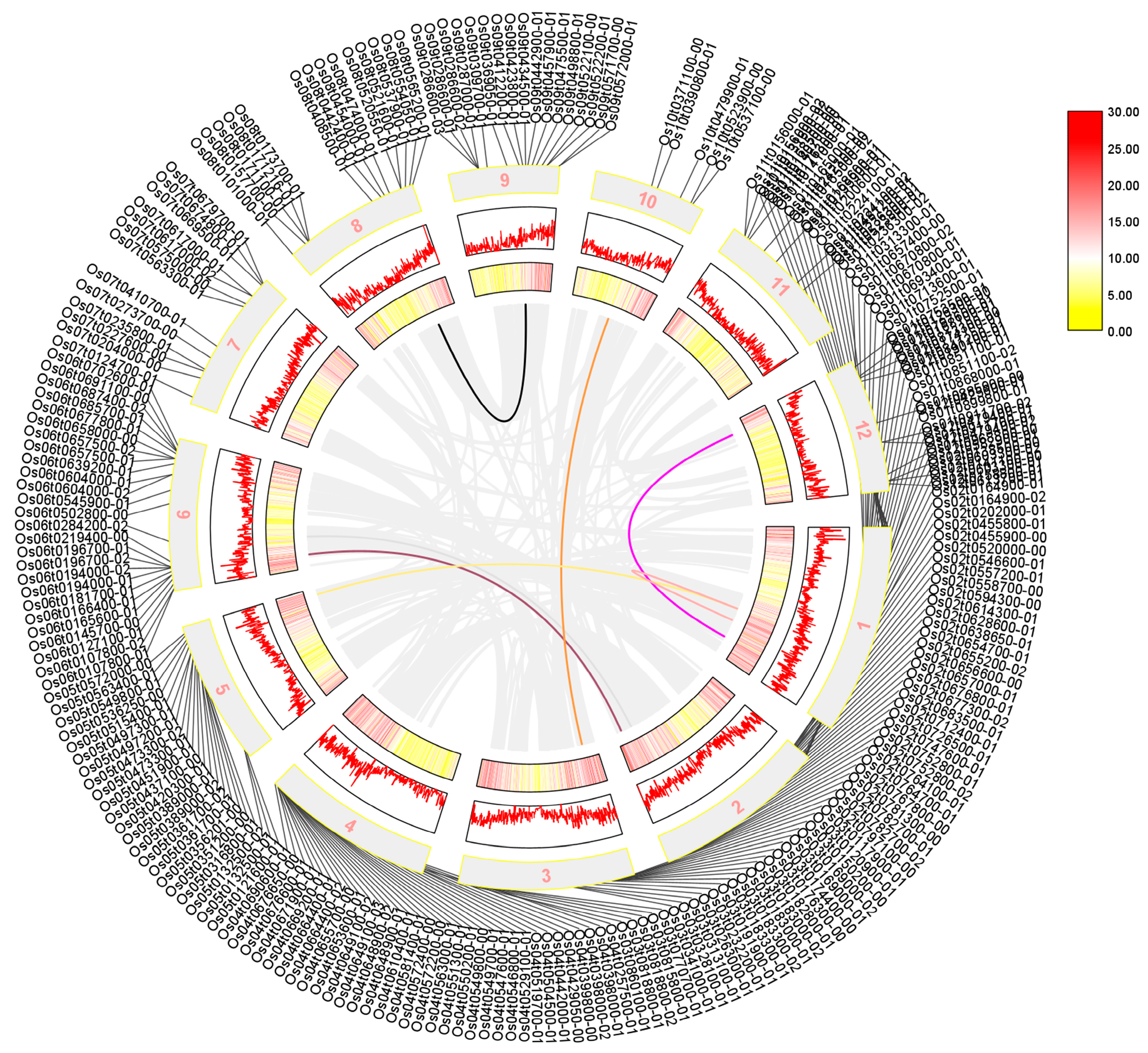


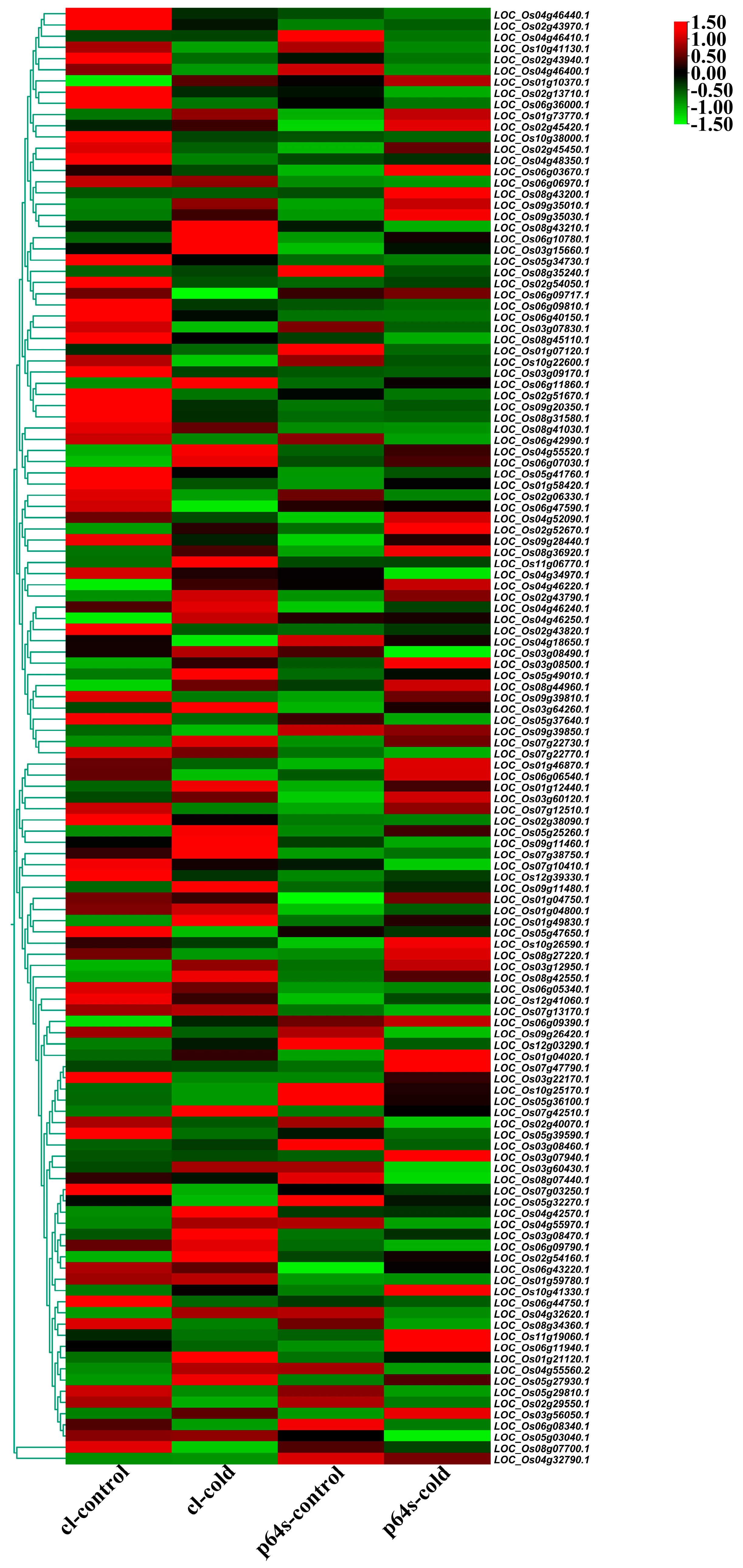
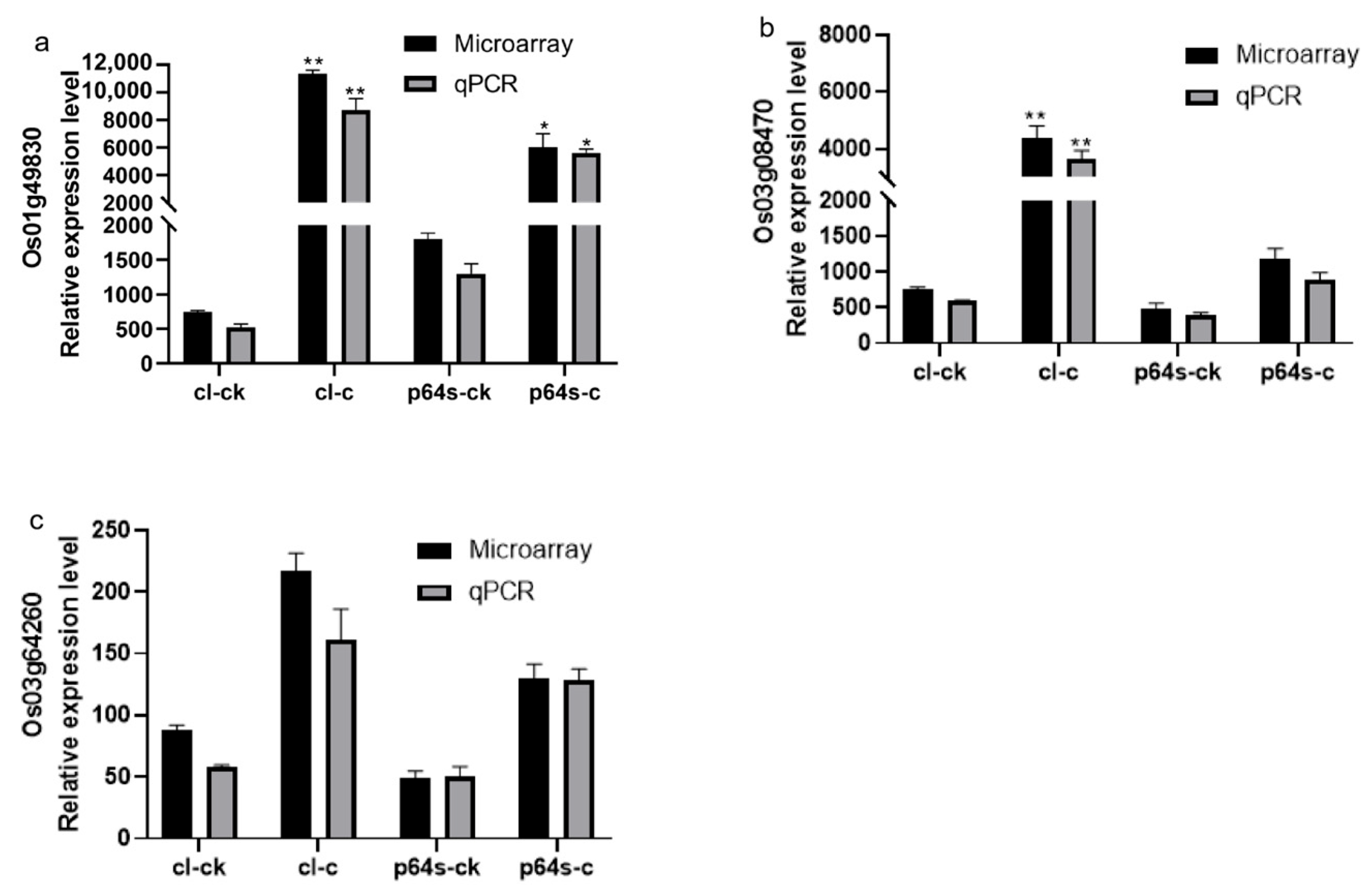

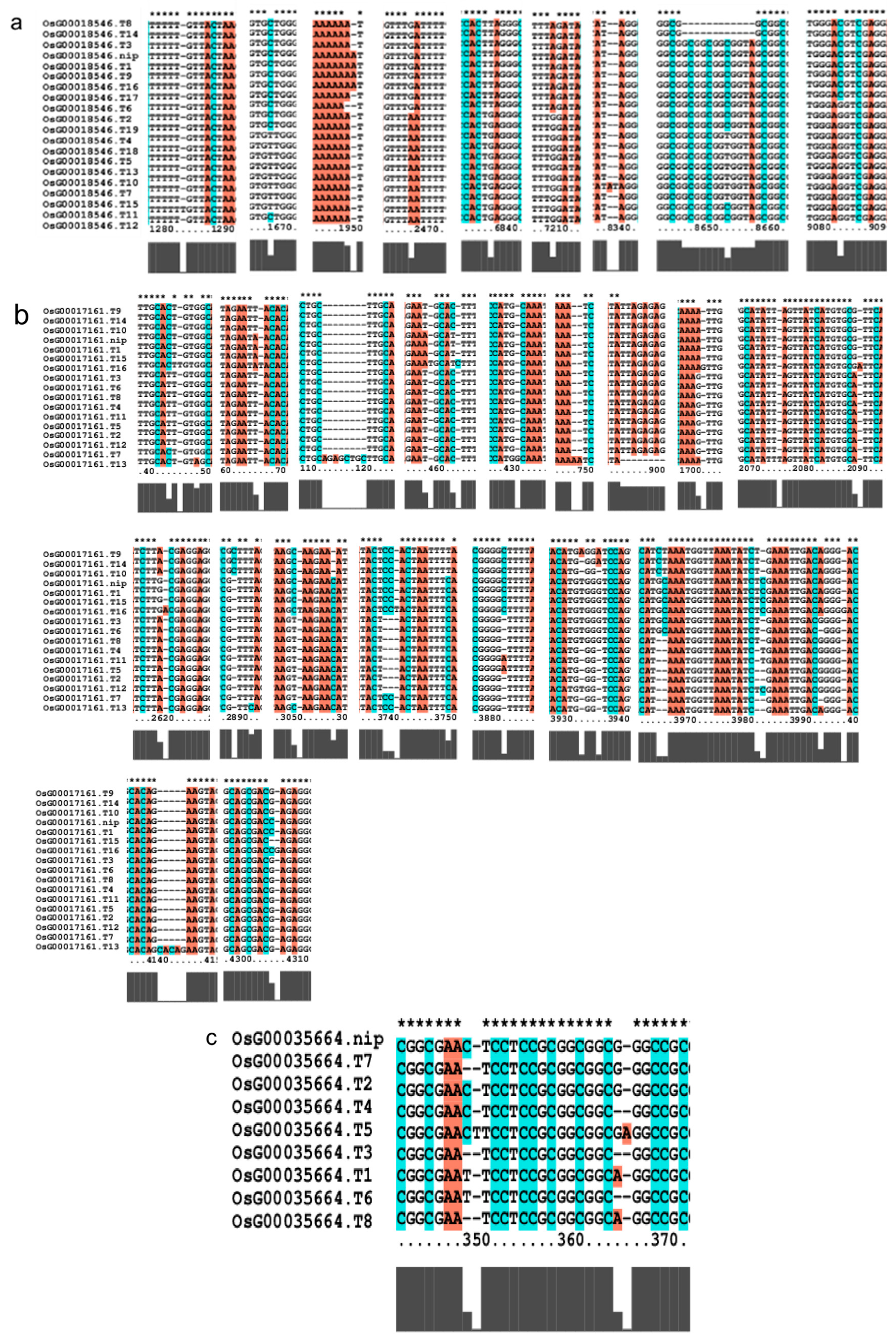

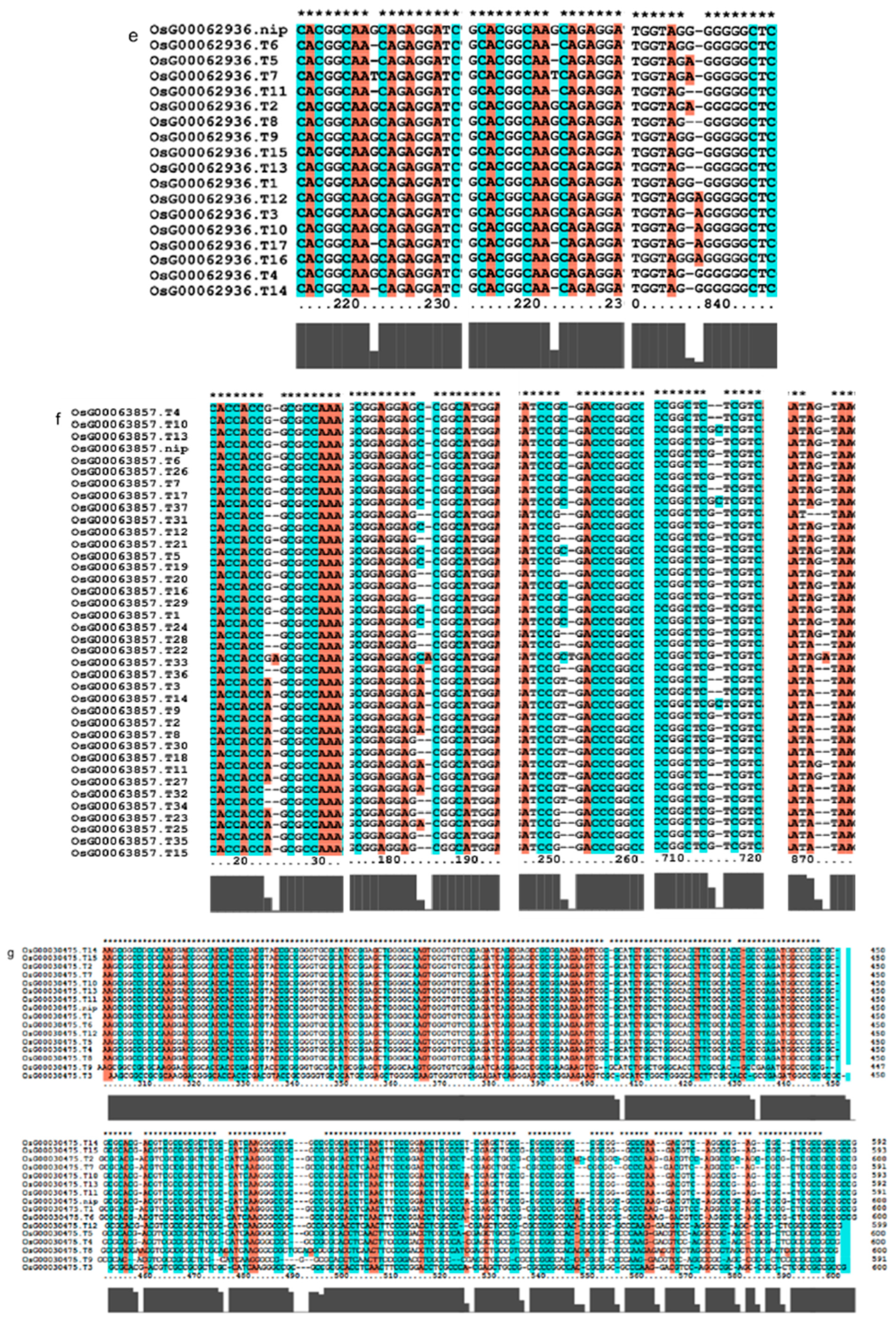

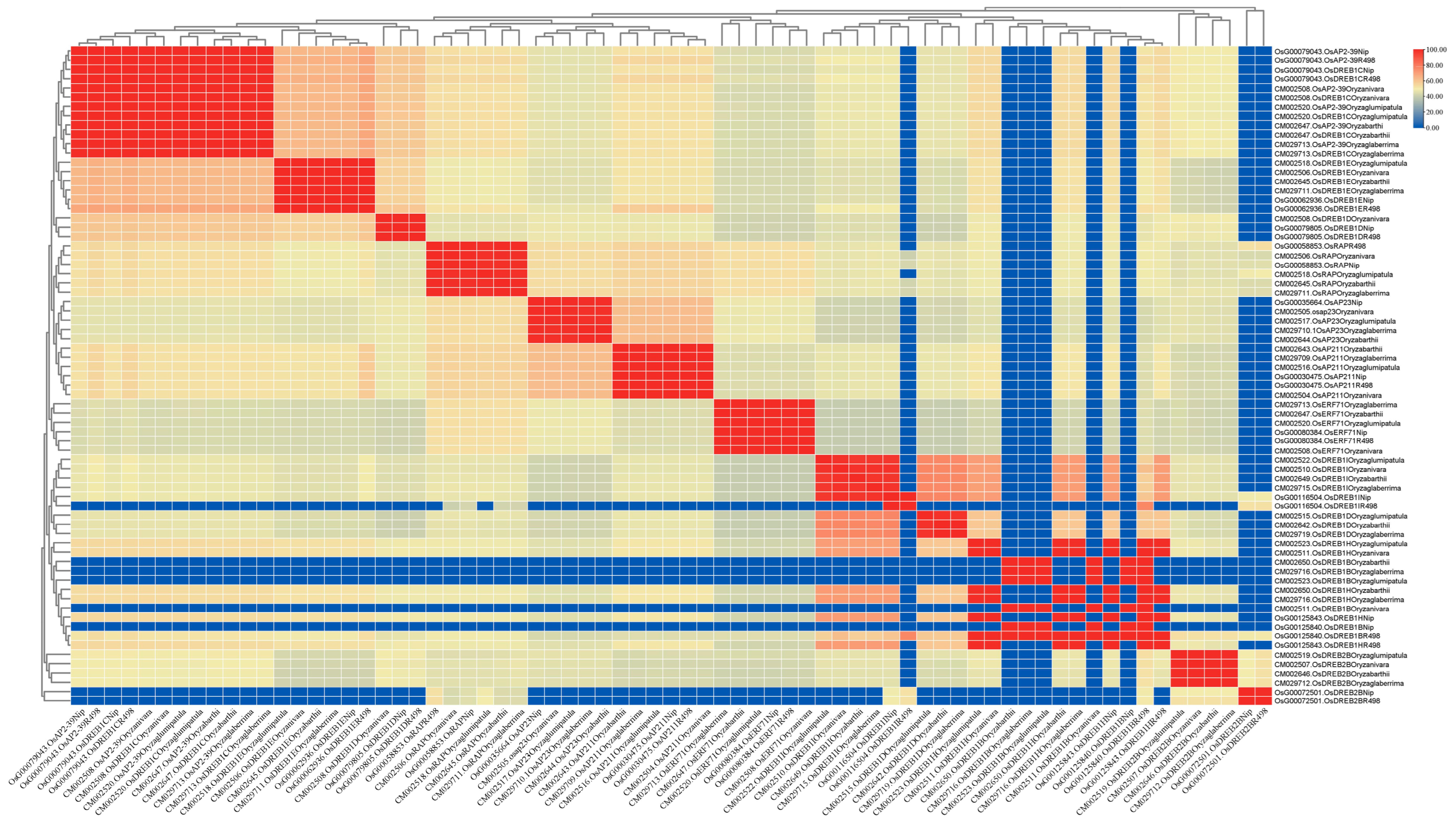

| Gene Identifier | Gene Description | [WT CD] vs. [WT CT] | [PEI’AI 64S DS] vs. [PEI’AI 64S CT] | |||
|---|---|---|---|---|---|---|
| Fold Change | Regulation | Fold Change | Regulation | |||
| LOC_Os01g04020 | Putative uncharacterized protein | 2.08 | up | 5.42 | up | |
| LOC_Os01g04750 | Putative AP2/ERF and B3 domain-containing protein | 0.87 | down | 15.01 | up | |
| LOC_Os01g04800 | AP2/ERF and B3 domain-containing protein | 1.17 | up | 2.31 | up | |
| LOC_Os01g07120 | Dehydration-responsive element-binding protein 2A | 0.89 | down | 0.56 | down | |
| * | LOC_Os01g10370 | Ap21 | 3.88 | up | 1.4 | up |
| LOC_Os01g12440 | Os01g0224100 protein | 4.52 | up | 17 | up | |
| * | LOC_Os01g21120 | Os01g0313300 protein | 54.57 | up | 18.67 | up |
| LOC_Os01g46870 | Ap24 | 0.52 | down | 4.01 | up | |
| * | LOC_Os01g49830 | AP2/ERF and B3 domain-containing protein | 15.5 | up | 3.5 | up |
| LOC_Os01g54890 | Os01g0752500 protein | 0.19 | down | 0.06 | down | |
| LOC_Os01g58420 | Ethylene-responsive element binding factor3 | 0.42 | down | 1.82 | up | |
| LOC_Os01g59780 | Os01g0813300 protein | 1.07 | up | 1.35 | up | |
| LOC_Os01g67410 | Os01g0899800 protein | 0.58 | down | 0.56 | down | |
| LOC_Os01g73770 | Dehydration-responsive element-binding protein 1F | 4.5 | up | 27.73 | down | |
| LOC_Os02g06330 | unknow | 0.15 | down | 0.27 | down | |
| LOC_Os02g13710 | Os02g0231000 protein | 0.34 | down | 0.12 | down | |
| LOC_Os02g29550 | Os02g0499000 protein | 0.43 | down | 0.51 | down | |
| LOC_Os02g38090 | Enhancer of shoot regeneration ESR1-like protein | 0.47 | down | 0.91 | down | |
| LOC_Os02g40070 | Os02g0654700 protein | 0.35 | down | 0.05 | down | |
| * | LOC_Os02g43790 | Os02g0654700 protein | 22.15 | up | 21.93 | up |
| LOC_Os02g43820 | Os02g0655200 protein | 0.5 | down | 1.14 | up | |
| LOC_Os02g43940 | Os02g0656600 protein | 0.1 | down | 0.26 | down | |
| LOC_Os02g43970 | Os02g0657000 protein | 0.46 | down | 1.26 | up | |
| LOC_Os02g45420 | Os02g0676800 protein | 1.08 | up | 1.42 | up | |
| LOC_Os02g45450 | Dehydration-responsive element-binding protein 1G | 0.25 | down | 33.88 | up | |
| LOC_Os02g51670 | Os02g0752800 protein | 0.23 | down | 0.51 | down | |
| * | LOC_Os02g52670 | AP2 domain-containing transcription factor-like | 6.78 | up | 2.23 | up |
| LOC_Os02g54050 | Os02g0781300 protein | 0.6 | down | 1.07 | up | |
| LOC_Os02g54160 | Ethylene-responsive transcription factor 1 | 2.37 | up | 1.24 | up | |
| LOC_Os03g05590 | AP2 domain-containing protein, expressed | 0.42 | down | 0.52 | down | |
| LOC_Os03g07830 | Dehydration-responsive element-binding protein 2E | 0.22 | down | 0.49 | down | |
| LOC_Os03g07940 | Putative uncharacterized protein | 1.17 | up | 9.92 | up | |
| * | LOC_Os03g08460 | AP2 domain-containing protein, expressed | 1.23 | up | 0.31 | down |
| * | LOC_Os03g08470 | AP2 domain-containing protein | 5.9 | up | 2.44 | up |
| * | LOC_Os03g08490 | Os03g0183200 protein | 1.12 | up | 0.74 | down |
| LOC_Os03g08500 | AP2 domain-containing protein, expressed | 1.82 | up | 1.89 | up | |
| LOC_Os03g09170 | AP2 domain-containing protein, expressed | 0.17 | down | 0.87 | down | |
| * | LOC_Os03g12950 | ANT, putative, expressed | 6.78 | up | 3.27 | up |
| LOC_Os03g15660 | AP2 domain-containing protein, expressed | 1.54 | up | 1.59 | up | |
| LOC_Os03g22170 | AP2 domain-containing protein, expressed | 0.28 | down | 2.31 | up | |
| LOC_Os03g56050 | Os03g0770700 protein | 7.06 | up | 38.47 | up | |
| LOC_Os03g60120 | AP2 domain-containing protein, expressed | 1.53 | up | 2.97 | up | |
| * | LOC_Os03g60430 | Os03g0818800 protein | 2.26 | up | 0.099 | up |
| LOC_Os03g64260 | AP2 domain-containing protein, expressed | 2.41 | up | 2.93 | up | |
| LOC_Os04g18650 | B1234D02.6 protein | 0.25 | down | 0.69 | down | |
| * | LOC_Os04g32620 | OSJNBa0039C07.10 protein | 1.51 | up | 0.67 | down |
| LOC_Os04g32790 | OSJNBb0014D23.10 protein | 0.83 | down | 0.75 | down | |
| LOC_Os04g34970 | OSJNBa0042L16.9 protein | 0.73 | down | 0.41 | down | |
| * | LOC_Os04g42570 | Os04g0504500 protein | 3.37 | up | 1.03 | up |
| * | LOC_Os04g46220 | Development-related ERF protein | 1.73 | up | 1.25 | up |
| LOC_Os04g46240 | Putative uncharacterized protein | 1.28 | up | 1.71 | up | |
| * | LOC_Os04g46250 | Ap26 | 2.28 | up | 0.99 | up |
| * | LOC_Os06g46410 | Auxin response factor 17 | 1.02 | up | 0.12 | down |
| LOC_Os04g46400 | OSJNBb0034G17.6 protein | 0.32 | down | 0.49 | down | |
| LOC_Os04g48350 | Dehydration-responsive element-binding protein 1E | 0.02 | down | 1.37 | up | |
| LOC_Os04g52090 | OSJNBa0085I10.10 protein | 0.57 | down | 5.5 | up | |
| * | LOC_Os04g55520 | OSJNBa0010D21.10 protein | 2.6 | up | 1.48 | up |
| * | LOC_Os04g55560 | Os04g0649100 protein | 3.25 | up | 0.28 | down |
| * | LOC_Os04g55970 | Os04g0653600 protein | 3.6 | up | 0.2 | down |
| * | LOC_Os05g03040 | Os05g0121600 protein | 1 | up | 0.42 | down |
| * | LOC_Os05g25260 | Os05g0316800 protein | 9.98 | up | 5.33 | up |
| * | LOC_Os05g27930 | unknown | 4.85 | up | 2.68 | up |
| LOC_Os05g29810 | Os05g0361700 protein | 0.08 | down | 0.03 | down | |
| LOC_Os05g32270 | Os05g0389000 protein | 0.58 | down | 0.6 | down | |
| LOC_Os05g34730 | Os05g0420300 protein | 0.34 | down | 0.36 | down | |
| LOC_Os05g36100 | Os05g0437050 protein | 0.71 | down | 0.6 | down | |
| LOC_Os05g37640 | Os05g0448675 protein | 0.19 | down | 0.08 | down | |
| LOC_Os05g39590 | Dehydration-responsive element-binding protein 2D | 0.13 | down | 0.36 | down | |
| LOC_Os05g41760 | Os05g0497200 protein | 0.48 | down | 1.86 | up | |
| LOC_Os05g41780 | Os05g0497300 protein | 0.49 | down | 3.43 | up | |
| LOC_Os05g47650 | Os05g0549800 protein | 0.31 | down | 0.8 | down | |
| * | LOC_Os05g49010 | Os05g0564700 protein | 5.51 | up | 1.89 | up |
| LOC_Os06g03670 | Dehydration-responsive element-binding protein 1C | 0.53 | down | 25.16 | up | |
| LOC_Os06g05340 | Os06g0145700 protein | 0.81 | down | 1.08 | up | |
| LOC_Os06g06540 | Putative uncharacterized protein | 0.48 | down | 1.78 | up | |
| LOC_Os06g06970 | Dehydration-responsive element-binding protein 1D | 0.87 | down | 0.58 | down | |
| * | LOC_Os06g07030 | Os06g0166400 protein | 11.59 | up | 1.94 | up |
| LOC_Os06g08340 | Os06g0181700 protein | 0.68 | down | 0.6 | down | |
| * | LOC_Os06g09390 | EREBP transcription factor | 1.53 | up | 1.11 | up |
| LOC_Os06g09717 | Putative uncharacterized protein | 0.31 | down | 1.11 | up | |
| * | LOC_Os06g09790 | Putative uncharacterized protein | 1.24 | up | 0.73 | down |
| LOC_Os06g09810 | Putative uncharacterized protein | 0.49 | down | 0.93 | down | |
| LOC_Os06g10780 | Putative uncharacterized protein | 4.14 | up | 4.25 | up | |
| * | LOC_Os06g11860 | Os06g0222400 protein | 1.5 | up | 1.15 | up |
| LOC_Os06g11940 | Putative uncharacterized protein | 0.44 | down | 10.7 | up | |
| LOC_Os06g36000 | Os06g0553700 protein | 0.09 | down | 0.22 | down | |
| LOC_Os06g40150 | AP domain containing transcription factor | 0.32 | down | 0.94 | down | |
| LOC_Os06g42990 | Putative uncharacterized protein | 0.4 | down | 0.4 | down | |
| LOC_Os06g43220 | Os06g0639200 protein | 0.86 | down | 4.53 | up | |
| LOC_Os06g44750 | Aintegumenta-like protein | 0.19 | down | 0.74 | down | |
| LOC_Os06g47590 | Os06g0691100 protein | 0.69 | down | 0.98 | down | |
| LOC_Os07g03250 | Os07g0124700 protein | 0.25 | down | 0.77 | down | |
| LOC_Os07g10410 | Os07g0204000 protein | 0.63 | down | 0.34 | down | |
| LOC_Os07g12510 | Os07g0227600 protein | 0.72 | down | 1.39 | up | |
| * | LOC_Os07g13170 | Os07g0235800 protein | 1.03 | up | 0.88 | down |
| * | LOC_Os07g22730 | Os07g0235800 protein | 2.05 | up | 1.77 | up |
| LOC_Os07g22770 | Os07g0410700 protein | 0.77 | down | 0.19 | down | |
| LOC_Os07g38750 | Os07g0575000 protein | 1.75 | up | 2.46 | up | |
| * | LOC_Os07g42510 | EREB-like protein | 21.1 | up | 1.077 | up |
| LOC_Os07g47330 | Frizzy panicle | 0.55 | down | 0.4 | down | |
| LOC_Os07g47790 | Os07g0674800 protein | 0.97 | down | 11.24 | up | |
| LOC_Os08g07440 | Os08g0171100 protein | 0.91 | down | 0.57 | down | |
| LOC_Os08g07700 | Os08g0173700 protein | 0.32 | down | 0.7 | down | |
| LOC_Os08g27220 | Os08g0360800 protein | 0.35 | down | 3.26 | up | |
| LOC_Os08g31580 | AP domain DRE binding factor | 0.5 | down | 1.02 | up | |
| LOC_Os08g34360 | AP2-EREBP transcription factor | 0.12 | down | 0.04 | down | |
| * | LOC_Os08g35240 | AP2 domain transcription factor-like | 1.89 | up | 0.11 | down |
| LOC_Os08g36920 | Os08g0474000 protein | 4.62 | up | 374.69 | up | |
| LOC_Os08g41030 | Os08g0521600 protein | 0.75 | down | 0.95 | down | |
| * | LOC_Os08g42550 | AP2 domain-containing protein AP29-like | 4.38 | up | 2.29 | up |
| LOC_Os08g43200 | Os08g0545500 protein | 0.85 | down | 10.47 | up | |
| * | LOC_Os08g43210 | Os08g0545500 protein | 1.92 | up | 0.51 | down |
| LOC_Os08g44960 | Putative uncharacterized protein | 1.47 | up | 1.3 | up | |
| LOC_Os08g45110 | Dehydration-responsive element-binding protein 2C | 0.54 | down | 0.49 | down | |
| * | LOC_Os09g11460 | AP2/ERF domain protein | 1.49 | up | 0.77 | down |
| * | LOC_Os09g11480 | AP2/ERF domain protein | 48.6 | up | 13.84 | up |
| LOC_Os09g20350 | Os09g0369000 protein | 0.36 | down | 1.29 | up | |
| LOC_Os09g26420 | Os09g0434500 protein | 0.81 | down | 0.73 | down | |
| LOC_Os09g28440 | Ethylene-binding protein-like | 0.42 | down | 38.84 | up | |
| LOC_Os12g41046 | unknown | 8.18 | up | 127.36 | up | |
| LOC_Os12g41047 | unknown | 6.32 | up | 119.7 | up | |
| LOC_Os12g41048 | unknown | 0.2 | down | 7.3 | up | |
| LOC_Os12g41049 | unknown | 0.57 | down | 0.89 | down | |
| LOC_Os12g41050 | Putative uncharacterized protein | 0.07 | down | 0.39 | down | |
| LOC_Os12g41051 | unknown | 0.68 | down | 0.58 | down | |
| LOC_Os12g41052 | unknown | 0.75 | down | 3.14 | up | |
| LOC_Os12g41053 | unknown | 0.23 | down | 0.81 | down | |
| LOC_Os12g41054 | unknown | 0.25 | down | 0.32 | down | |
| LOC_Os12g41055 | unknown | 34.3 | up | 95.17 | up | |
| * | LOC_Os12g41056 | unknown | 4.41 | up | 1.02 | up |
| LOC_Os12g41057 | unknown | 0.29 | down | 8.66 | up | |
| * | LOC_Os12g41058 | unknown | 2.13 | up | 0.25 | down |
| LOC_Os12g41059 | unknown | 0.6 | down | 1.18 | up | |
| LOC_Os12g41060 | AP2 domain-containing protein, expressed | 0.78 | down | 1.34 | up | |
| cis-Regulatory Elements | Function | Numbers |
|---|---|---|
| ABRE | cis-acting element involved in the abscisic acid responsiveness | 587 |
| ACE | cis-acting element involved in light responsiveness | 39 |
| ARE | cis-acting regulatory element essential for the anaerobic induction | 261 |
| ERE | ethylene-responsive element | 108 |
| GA-motif | part of a light-responsive element | 25 |
| GCN4_motif | cis-regulatory element involved in endosperm expression | 22 |
| GT1-motif | light-responsive element | 127 |
| LTR | cis-acting element involved in low-temperature responsiveness | 77 |
| MBS | MYB binding site involved in drought-inducibility | 98 |
| MRE | MYB binding site involved in light responsiveness | 47 |
| O2-site | cis-acting regulatory element involved in zein metabolism regulation | 76 |
| TC-rich repeats | cis-acting element involved in defense and stress responsiveness | 42 |
| TCA-element | cis-acting element involved in salicylic acid responsiveness | 66 |
| TGACG-motif | cis-acting regulatory element involved in the MeJA-responsiveness | 309 |
| circadian | cis-acting regulatory element involved in circadian control | 30 |
| Genes | Variety | Location | Promoter Sequence |
|---|---|---|---|
| Os01g49830 | Chaling wild rice | −1038 | TCCCTCATCTCCCCTG |
| Pei’64s | −1038 | TCCCTCATCTGCCCTG | |
| Os03g08470 | Chaling wild rice | −1598 | AATAACGTGTGATTAA |
| Pei’64s | −1598 | AATAACATGTGATTAA | |
| Os03g64260 | Chaling wild rice | −961 | TGAATCAAAGGAAAAA |
| Pei’64s | −961 | TGAATCAAATGAAAAA |
Disclaimer/Publisher’s Note: The statements, opinions and data contained in all publications are solely those of the individual author(s) and contributor(s) and not of MDPI and/or the editor(s). MDPI and/or the editor(s) disclaim responsibility for any injury to people or property resulting from any ideas, methods, instructions or products referred to in the content. |
© 2023 by the authors. Licensee MDPI, Basel, Switzerland. This article is an open access article distributed under the terms and conditions of the Creative Commons Attribution (CC BY) license (https://creativecommons.org/licenses/by/4.0/).
Share and Cite
Yang, S.; Zhou, J.; Li, Y.; Wu, J.; Ma, C.; Chen, Y.; Sun, X.; Wu, L.; Liang, X.; Fu, Q.; et al. AP2/EREBP Pathway Plays an Important Role in Chaling Wild Rice Tolerance to Cold Stress. Int. J. Mol. Sci. 2023, 24, 14441. https://doi.org/10.3390/ijms241914441
Yang S, Zhou J, Li Y, Wu J, Ma C, Chen Y, Sun X, Wu L, Liang X, Fu Q, et al. AP2/EREBP Pathway Plays an Important Role in Chaling Wild Rice Tolerance to Cold Stress. International Journal of Molecular Sciences. 2023; 24(19):14441. https://doi.org/10.3390/ijms241914441
Chicago/Turabian StyleYang, Songjin, Jingming Zhou, Yaqi Li, Jiacheng Wu, Chuan Ma, Yulin Chen, Xingzhuo Sun, Lingli Wu, Xin Liang, Qiuping Fu, and et al. 2023. "AP2/EREBP Pathway Plays an Important Role in Chaling Wild Rice Tolerance to Cold Stress" International Journal of Molecular Sciences 24, no. 19: 14441. https://doi.org/10.3390/ijms241914441
APA StyleYang, S., Zhou, J., Li, Y., Wu, J., Ma, C., Chen, Y., Sun, X., Wu, L., Liang, X., Fu, Q., Xu, Z., Li, L., Huang, Z., Zhu, J., Jia, X., Ye, X., & Chen, R. (2023). AP2/EREBP Pathway Plays an Important Role in Chaling Wild Rice Tolerance to Cold Stress. International Journal of Molecular Sciences, 24(19), 14441. https://doi.org/10.3390/ijms241914441






